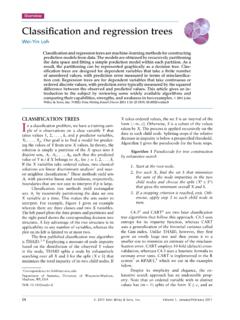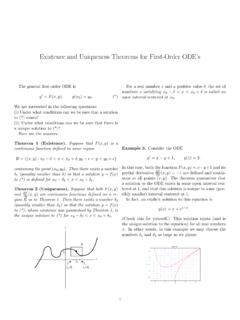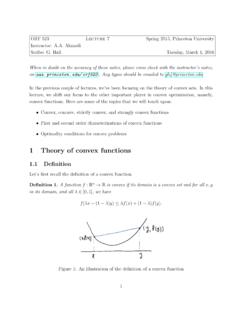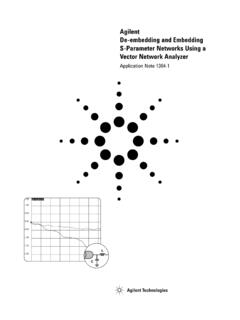Transcription of Generalized Intersection over Union: A Metric and A Loss ...
1 Generalized Intersection over Union: A Metric and A Loss for Bounding BoxRegressionHamid Rezatofighi1,2 Nathan Tsoi1 JunYoung Gwak1 Amir Sadeghian1,3 Ian Reid2 Silvio Savarese11 Computer Science Department, Stanford University, United states2 School of Computer Science, The University of Adelaide, Australia3 Aibee Inc, over Union (IoU) is the most popular evalu-ation Metric used in the object detection benchmarks. How-ever, there is a gap between optimizing the commonly useddistance losses for regressing the parameters of a boundingbox and maximizing this Metric value. The optimal objec-tive for a Metric is the Metric itself. In the case of axis-aligned 2D bounding boxes, it can be shown thatIoUcanbe directly used as a regression loss.
2 However,IoUhas aplateau making it infeasible to optimize in the case of non-overlapping bounding boxes. In this paper, we address theweaknesses ofIoUby introducing a Generalized version asboth a new loss and a new Metric . By incorporating thisgeneralizedIoU(GIoU) as a loss into the state-of-the artobject detection frameworks, we show a consistent improve-ment on their performance using both the standard,IoUbased, and new,GIoUbased, performance measures onpopular object detection benchmarks such as PASCAL VOCand MS IntroductionBounding box regression is one of the most fundamentalcomponents in many 2D/3D computer vision tasks. Taskssuch as object localization, multiple object detection, ob-ject tracking and instance level segmentation rely on ac-curate bounding box regression.
3 The dominant trend forimproving performance of applications utilizing deep neu-ral networks is to propose either a better architecture back-bone [15,13] or a better strategy to extract reliable localfeatures [6]. However, one opportunity for improvementthat is widely ignored is the replacement of the surrogateregression losses such as 1and 2-norms, with a metricloss calculated based on Intersection over Union (IoU).||.||2 = ||.||2 = ||.||2 = (a)||.||1 = = = ||.||1 = = = ||.||1 = = = (b)Figure 1. Two sets of examples (a) and (b) with the boundingboxes represented by (a) two corners(x1, y1, x2, y2)and (b) cen-ter and size(xc, yc, w, h). For all three cases in each set (a) 2-norm distance,||.
4 ||2, and (b) 1-norm distance,||.||1, between therepresentation of two rectangles are exactly same value, but theirIoUandGIoUvalues are very , also known as Jaccard index, is the most commonlyused Metric for comparing the similarity between two arbi-trary the shape properties of the ob-jects under comparison, the widths, heights and loca-tions of two bounding boxes, into the region property andthen calculates a normalized measure that focuses on their1areas (or volumes). This property makesIoUinvariant tothe scaleof the problem under consideration. Due to thisappealing property, all performance measures used to eval-uate for segmentation [2,1,25,14], object detection [14,4],and tracking [11,10] rely on this , it can be shown that there is not a strong cor-relation between minimizing the commonly used losses, n-norms, defined on parametric representation of twobounding boxes in 2D/3D and improving example, consider the simple 2D scenario in (a),where the predicted bounding box (black rectangle), and theground truth box (green rectangle), are represented by theirtop-left and bottom-right corners, (x1, y1, x2, y2).
5 Forsimplicity, let s assume that the distance, 2-norm, be-tween one of the corners of two boxes is fixed. Thereforeany predicted bounding box where the second corner lieson a circle with a fixed radius centered on the second cornerof the green rectangle (shown by a gray dashed line cir-cle) will have exactly the same 2-norm distance from theground truth box; however theirIoUvalues can be signifi-cantly different ( (a)). The same argument can be ex-tended to any other representation and loss, (b).It is intuitive that a good local optimum for these types ofobjectives may not necessarily be a local optimum , in contrast toIoU, n-norm objectives definedbased on the aforementioned parametric representations arenot invariant to the scale of the problem.
6 To this end, severalpairs of bounding boxes with the same level of overlap, butdifferent scales due perspective, will have differentobjective values. In addition, some representations may suf-fer from lack of regularization between the different typesof parameters used for the representation. For example, inthe center and size representation,(xc, yc)is defined on thelocation space while(w, h)belongs to the size space. Com-plexity increases as more parameters are incorporated, , or when adding more dimensions to the alleviate some of the aforementioned problems, state-of-the-art object detectors introduce the concept of an anchorbox [22] as a hypothetically good initial guess. They alsodefine a non-linear representation [19,5] to naively com-pensate for the scale changes.
7 Even with these handcraftedchanges, there is still a gap between optimizing the regres-sion losses this paper, we explore the calculation ofIoUbetweentwo axis aligned rectangles, or generally two axis aligned n-orthotopes, which has a straightforward analytical solutionand in contrast to the prevailing belief,IoUin this case canbe backpropagated [24], it can be directly used as theobjective function to optimize. It is therefore preferable touseIoUas the objective function for 2D object detectiontasks. Given the choice between optimizing a Metric itselfvs. a surrogate loss function, the optimal choice is the met-ric itself. However,IoUas both a Metric and a loss has amajor issue: if two objects do not overlap, theIoUvaluewill be zero and will not reflect how far the two shapes arefrom each other.
8 In this case of non-overlapping objects, ifIoUis used as a loss, its gradient will be zero and cannotbe this paper, we will address this weakness ofIoUbyextending the concept to non-overlapping cases. We ensurethis generalization (a) follows the same definition asIoU, encoding the shape properties of the compared objectsinto the region property; (b) maintains the scale invariantproperty ofIoU, and (c) ensures a strong correlation withIoUin the case of overlapping objects. We introduce thisgeneralized version ofIoU, namedGIoU, as a new met-ric for comparing any two arbitrary shapes. We also pro-vide an analytical solution for calculatingGIoUbetweentwo axis aligned rectangles, allowing it to be used as a lossin this case.
9 IncorporatingGIoUloss into state-of-the artobject detection algorithms, we consistently improve theirperformance on popular object detection benchmarks suchas PASCAL VOC [4] and MS COCO [14] using both thestandard, [4,14], and the new,GIoUbased,performance main contribution of the paper is summarized as fol-lows: We introduce this Generalized version ofIoU, as a newmetric for comparing any two arbitrary shapes. We provide an analytical solution for usingGIoUasloss between two axis-aligned rectangles or generallyn-orthotopes1. We incorporateGIoUloss into the most popularobject detection algorithms such as Faster R-CNN,Mask R-CNN and YOLO v3, and show their per-formance improvement on standard object Related WorkObject detection accuracy measures: Intersection overUnion (IoU) is the defacto evaluation Metric used in objectdetection.
10 It is used to determine true positives and falsepositives in a set of predictions. When usingIoUas an eval-uation Metric an accuracy threshold must be chosen. Forinstance in the PASCAL VOC challenge [4], the widely re-ported detection accuracy measure, mean Average Pre-cision (mAP), is calculated based on a fixedIoUthreshold, However, an arbitrary choice of theIoUthresholddoes not fully reflect the localization performance of dif-ferent methods. Any localization accuracy higher than thethreshold is treated equally. In order to make this perfor-mance measure less sensitive to the choice ofIoUthresh-old, the MS COCO Benchmark challenge [14] averagesmAP across provided in supp. materialBounding box representations and losses:In 2D ob-ject detection, learning bounding box parameters is bounding box representations and losses have beenproposed in the literature.





